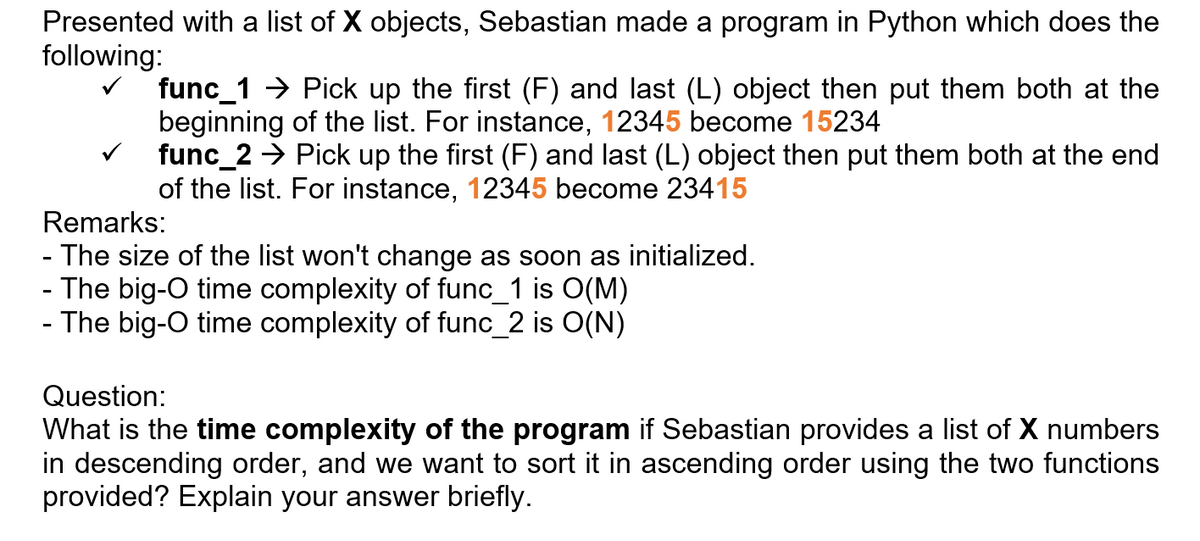Presented with a list of X objects, Sebastian made a program in Python which does the following: func_1 > Pick up the first (F) and last (L) object then put them both at the beginning of the list. For instance, 12345 become 15234 func_2 → Pick up the first (F) and last (L) object then put them both at the end of the list. For instance, 12345 become 23415 Remarks: - The size of the list won't change as soon as initialized. - The big-O time complexity of func_1 is O(M) The big-O time complexity of func_2 is O(N) Question: What is the time complexity of the program if Sebastian provides a list of X numbers in descending order, and we want to sort it in ascending order using the two functions provided? Explain your answer briefly.
Presented with a list of X objects, Sebastian made a program in Python which does the following: func_1 > Pick up the first (F) and last (L) object then put them both at the beginning of the list. For instance, 12345 become 15234 func_2 → Pick up the first (F) and last (L) object then put them both at the end of the list. For instance, 12345 become 23415 Remarks: - The size of the list won't change as soon as initialized. - The big-O time complexity of func_1 is O(M) The big-O time complexity of func_2 is O(N) Question: What is the time complexity of the program if Sebastian provides a list of X numbers in descending order, and we want to sort it in ascending order using the two functions provided? Explain your answer briefly.
Computer Networking: A Top-Down Approach (7th Edition)
7th Edition
ISBN:9780133594140
Author:James Kurose, Keith Ross
Publisher:James Kurose, Keith Ross
Chapter1: Computer Networks And The Internet
Section: Chapter Questions
Problem R1RQ: What is the difference between a host and an end system? List several different types of end...
Related questions
Question
I need your help so I can learn.

Transcribed Image Text:Presented with a list of X objects, Sebastian made a program in Python which does the
following:
func_1 > Pick up the first (F) and last (L) object then put them both at the
beginning of the list. For instance, 12345 become 15234
v func_2 → Pick up the first (F) and last (L) object then put them both at the end
of the list. For instance, 12345 become 23415
Remarks:
- The size of the list won't change as soon as initialized.
- The big-O time complexity of func_1 is O(M)
- The big-O time complexity of func_2 is O(N)
Question:
What is the time complexity of the program if Sebastian provides a list of X numbers
in descending order, and we want to sort it in ascending order using the two functions
provided? Explain your answer briefly.
Expert Solution
This question has been solved!
Explore an expertly crafted, step-by-step solution for a thorough understanding of key concepts.
Step by step
Solved in 2 steps

Recommended textbooks for you

Computer Networking: A Top-Down Approach (7th Edi…
Computer Engineering
ISBN:
9780133594140
Author:
James Kurose, Keith Ross
Publisher:
PEARSON

Computer Organization and Design MIPS Edition, Fi…
Computer Engineering
ISBN:
9780124077263
Author:
David A. Patterson, John L. Hennessy
Publisher:
Elsevier Science

Network+ Guide to Networks (MindTap Course List)
Computer Engineering
ISBN:
9781337569330
Author:
Jill West, Tamara Dean, Jean Andrews
Publisher:
Cengage Learning

Computer Networking: A Top-Down Approach (7th Edi…
Computer Engineering
ISBN:
9780133594140
Author:
James Kurose, Keith Ross
Publisher:
PEARSON

Computer Organization and Design MIPS Edition, Fi…
Computer Engineering
ISBN:
9780124077263
Author:
David A. Patterson, John L. Hennessy
Publisher:
Elsevier Science

Network+ Guide to Networks (MindTap Course List)
Computer Engineering
ISBN:
9781337569330
Author:
Jill West, Tamara Dean, Jean Andrews
Publisher:
Cengage Learning

Concepts of Database Management
Computer Engineering
ISBN:
9781337093422
Author:
Joy L. Starks, Philip J. Pratt, Mary Z. Last
Publisher:
Cengage Learning

Prelude to Programming
Computer Engineering
ISBN:
9780133750423
Author:
VENIT, Stewart
Publisher:
Pearson Education

Sc Business Data Communications and Networking, T…
Computer Engineering
ISBN:
9781119368830
Author:
FITZGERALD
Publisher:
WILEY